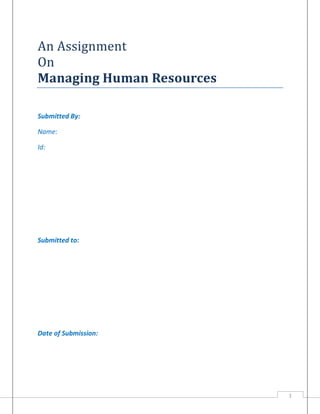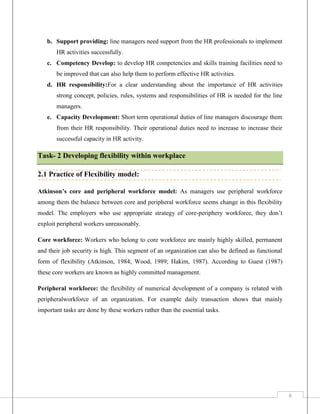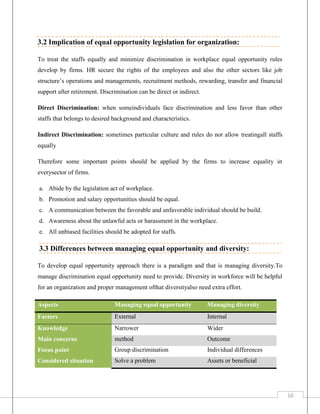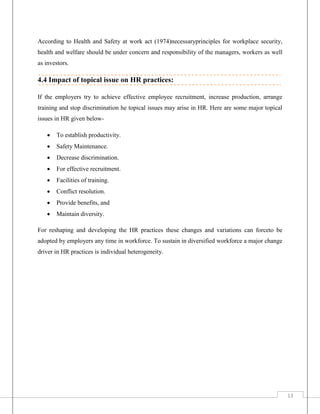Mhr 5
- 1. An Assignment On Managing Human Resources Submitted By: Name: Id: Submitted to: Date of Submission: 1
- 2. Table of Content: Page No: Executive Summary: iii Task- 1 Different perspective of Human resource management 1.1 Guest’s model of HRM: 4 1.2 Difference between Story’s definition on HRM, personnel and industrial relations: 5 1.3 Developing a strategic approach to HRM and impact of line managers and employees: 5 Task- 2 Developing flexibility within workplace 2.1 Practice of Flexibility model: 6 2.2 Types of flexibility for organizations: 7 2.3 Flexible working practices from employer and employee perspective: 7 2.4 Impact of changes in labor market on flexible working practice: 8 Task- 3 Impact of equal opportunities in workplace 3.1 Discrimination in workplace: 8 3.2 Implication of equal opportunity legislation for organization: 10 3.3 Differences between managing equal opportunity and diversity: 10 Task- 4 Approaches to human resource practices 4.1 Comparing methods of performance management: 11 4.2 Evaluation of employee welfare management: 12 4.3 Implication of health and safety legislation on HR: 12 4.4 Impact of topical issue on HR practices: 13 References: 14 2
- 3. Executive Summary: Human resource management means the activities and responsibilities of employers that include motivation, development, maintenance and personal management. For a firm, HRM is very necessarypart as all other segments mostly depend on HRM for recruitment and management of their staff. The main functions and common activities of HRM are basically to recruit, select candidates, improve performance, rewardemployees and maintain safe workplace. The more a firm have safe working environment, less discrimination, benefit for motivation etc. the more the employers areflexible with the issue in the workplace.Effective HR activities are focused by the employers so that they can uphold the brand image of their firms in the labor market and recruit available skillful employees. HR managers design the policies so that they can provide equal opportunities considering gender, age difference and other factors. Demography and alterations of labor market have pressurized the firms to reformulate their HR approaches and activities. To achieve a successful organization both the employers and employees should be responsible and contribute in HRM. 3
- 4. Task- 1 Different perspective of Human resource management 1.1 Guest’s model of HRM: A superior HR model compared to other HR models was introduced by David Guest (1997). According to this model different strategies should be initiated by the HR manager that will require some particular practices by which the manager will receive the output. This model has six components which are given below orderlyHR strategies HR practices HR outcomes Behavioral outcomes Performance result Financial consequences Unilever, as one of the biggest merchandise producers among the worldwide consumer aim to attain sustainable growth, reduce the environmental impact by their production and double their revenue. The HR policy of Unilever that adopt the Guest’s model is given belowThe HR policies established by Unilever are linked with the core functions and objectives of the organization. Worker management are very structured in supply chain, working environment are not gender biased, committed for long term, equal rights and also maintain child labor policy. Through these the employers get motivated, become more objective-oriented and satisfied with their job. The employees improve their performance to a standard levelfocusing on objectives and values of business. The involvement of employee, co-operation among them and actions focused on customer brought increased profit and achieved more customer and share in market. 4
- 5. 1.2 Difference between Story’s definition on HRM, personnel and industrial relations: HRM Personnel management Definition: It means the Definition: Industrial relations Efficiency Definition: development and application of maintenance in personnel relations HR that management suppliers includesstaffs, job group, and is focused in it and the among means interaction the firm’s customer, administrative function of management ensures lead, personal management. employees inspiration and commitment to the group, and the government. attain the goals of organization. Unilever arranges health hygiene facilities for & Unilever organize different It attains almost all the areas their training, experience sharing, of HRM, relation of labor- customers, consult with their guideline and thus maintain union and employee also. suppliers and experts for effective the performance of their and sustainable relation in supply- employee chain. which is the personnel development. 1.3 Developing a strategic approach to HRM and impact of line managers and employees: HRM process basically means a system of recruiting, training and improving the human resources of the organization. Suitable and skilled employees are being recruited by Unilever so that can sustain with the changing environmental situation, and also to raise their cultural value.HR line managers are mainly take responsibilities to apply HR requirements to deal with the present corporate environment. Here are some approaches which can be very helpful for Unilevera. Desire Creating:At first the line managers need to feel the desire and necessity of HR responsibilities and activities. HR department can help them to create desire of implementing HR approaches in their firms more efficiently and virtually. 5
- 6. b. Support providing: line managers need support from the HR professionals to implement HR activities successfully. c. Competency Develop: to develop HR competencies and skills training facilities need to be improved that can also help them to perform effective HR activities. d. HR responsibility:For a clear understanding about the importance of HR activities strong concept, policies, rules, systems and responsibilities of HR is needed for the line managers. e. Capacity Development: Short term operational duties of line managers discourage them from their HR responsibility. Their operational duties need to increase to increase their successful capacity in HR activity. Task- 2 Developing flexibility within workplace 2.1 Practice of Flexibility model: Atkinson’s core and peripheral workforce model: As managers use peripheral workforce among them the balance between core and peripheral workforce seems change in this flexibility model. The employers who use appropriate strategy of core-periphery workforce, they don’t exploit peripheral workers unreasonably. Core workforce: Workers who belong to core workforce are mainly highly skilled, permanent and their job security is high. This segment of an organization can also be defined as functional form of flexibility (Atkinson, 1984; Wood, 1989; Hakim, 1987). According to Guest (1987) these core workers are known as highly committed management. Peripheral workforce: the flexibility of numerical development of a company is related with peripheralworkforce of an organization. For example daily transaction shows that mainly important tasks are done by these workers rather than the essential tasks. 6
- 7. 2.2 Types of flexibility for organizations: Swiftness of workers adaptability to fluctuations and labor market’s changes of demand-supply curve shows by the flexibility of workplace. The most appropriate approach is Atkinson’s flexibility type. For Unilever there are four useful approaches for their personal work environment to achieveflexible equilibrium and those are the followings: a. Functional flexibility: the workers can move from on function to another in an organization by this. Functional flexibility also involves the training and outsourcing of the activities. b. External numerical flexibility:It means entry of labor from outsource of labor and their adaptation. It is designed with some actions such as acquisition of temporary workers, security legislation of the employee so that they can fire the permanent employees if needed. c. Financial flexibility: it involves variation in the wage level among the workers but collectively unfixed. Through assessment and performance this flexibility of payment can be achieved. d. Temporal flexibility: It means adaptability of working shifts, flexibility of time and schedule and overtime for current workers. e. Locational flexibility: it can be achieved assessing the activities of the workers outside the typical workplace. 2.3 Flexible working practices from employer and employee perspective: Some flexibility practices are there to use commonly in workplace on viewpoint of both the employer and employee: o Part-time:mean the workers who work less than the full-time workers of like 30-35 hours per week. o Homeworking:these workers are mainly hired by the companies to complete specific tasks from their home. o Job sharing: It is a part-time basis job where two workers share their works with each other.But compensation of per employee gets reduced by sharing job. 7
- 8. o Staggered hours:in this flexibility employees can arrive and leave from the working place whenever they like but also create an overlapping period. o Tele working: The workers mainly do their work through mobile telecommunication from their home or outside rather than coming to the working place. o Compressed hours: Employees have to work total 5 fixed days and hours weeklyandevery week they enjoy a full day off. o Zero hour contract: The employers can arrange an on-call system that includes no specific time for the employees. Accepting and rejecting the work totally depend on the employee and employer, and also the payment depend on the hours the employee work. 2.4 Impact of changes in labor market on flexible working practice: Labor market is changing often with the changing factors like economic, social and environmental. Organizational strategic goal should be achieved if the firms confirm about the skills and competency level for job position while they hire employees.The flexibility of workplace in labor market needs to be related with the changes in supply and demand curve. Demographic phases in labor market: since a long period of time the components of labor market like supply and demand have been shaping bydemographic trend.Lower birthrateis decreasing the supply of new labor in the market. At the same time lengthy life expectation broaden up the supply of older worker who have to work even after retirement. Participation of women increase in workplace and it changed the environment, policies and gender ratio in workplace. The flexibility approaches in workplace are also changing with this type of demographic changes. To achieve organizational strategic goal diverse workforce andtheir changing condition of demographic needs different flexibility. Task- 3 Impact of equal opportunities in workplace 3.1 Discrimination in workplace: In Workplace the workers often face different types of discriminations. According to ILO there are discrimination on the basis of the differences in background of individual, their race, age, gender and characteristics that hamper equal opportunity at their workplace. Discrimination in workers of a firm hampers the human development process, humiliation and violations occur and 8
- 9. all these cause the loss of workers motivation and standard. Thus firm get in troubleand fail to achieve its goal and objectives of HRM. Age Discrimination:age discriminate theStaffs from enjoying the opportunities of promotion, transfer and authority. HRM managers need to ensure equal opportunities, reward, promotion and transfer facilities for every staffs on the basis of their performances and achievements rather than their age. Discrimination of background: the workers who belong to very respective, corporate family background they often get better treatment than the other workers. They get more attention and facilities in their professional life and career rather than one comes from ordinary family background.All the staffsneed get treated equally on the basis of their skills not with their background. Religious Discrimination: religious discrimination is also there and it mostly seen on the minority religious group’s Staff. They have to face different problems with the firm’s culture, structure, policy etc. Corporate policies need to pay respect on the religious difference and set equal facilities for them also. Discrimination of disability: In the recruitment processdisable candidates are often get underestimated and neglected ignoring their skills and abilities.But they also possess expertise in particular sectors that other normal people are unable to do.This type of immature behavior of the employers should be stopped and they should offer job to the disable person on the basis of their ability and treat them equally like other staffs. Gender Discrimination: women mostly face discrimination in the workplace while enjoying opportunities and dignity than the male workers.It discourages the female workers to participate in the corporate world. In this regard firms need to be gender sensitive and ensure that both male and female workers enjoy equal rights in promotion and responsibility. 9
- 10. 3.2 Implication of equal opportunity legislation for organization: To treat the staffs equally and minimize discrimination in workplace equal opportunity rules develop by firms. HR secure the rights of the employees and also the other sectors like job structure’s operations and managements, recruitment methods, rewarding, transfer and financial support after retirement. Discrimination can be direct or indirect. Direct Discrimination: when someindividuals face discrimination and less favor than other staffs that belongs to desired background and characteristics. Indirect Discrimination: sometimes particular culture and rules do not allow treatingall staffs equally Therefore some important points should be applied by the firms to increase equality in everysector of firms. a. Abide by the legislation act of workplace. b. Promotion and salary opportunities should be equal. c. A communication between the favorable and unfavorable individual should be build. d. Awareness about the unlawful acts or harassment in the workplace. e. All unbiased facilities should be adopted for staffs. 3.3 Differences between managing equal opportunity and diversity: To develop equal opportunity approach there is a paradigm and that is managing diversity.To manage discrimination equal opportunity need to provide. Diversity in workforce will be helpful for an organization and proper management ofthat diversityalso need extra effort. Aspects Managing equal opportunity Managing diversity Factors External Internal Knowledge Narrower Wider Main concerns method Outcome Focus point Group discrimination Individual differences Considered situation Solve a problem Assets or beneficial 10
- 11. Approach structure Operational Strategic Suggestion for Effort Assimilation Mainstream adaptation Task- 4 Approaches to human resource practices 4.1 Comparing methods of performance management: Performance assessment can be helpful for a firm to improve their staff’s performance. To evaluate the performance there are different techniques for assessment. To evaluate the quality and quantity of performance there are some techniques and those are: Assessment centers: the performance ofmanagers ismeasured by trainers while they join assessment centers.Different types ofmaneuvers such as scenario of virtual work, group mission, the communiquéaptitude, proficiency of planning, leadership quality, creativity, tolerance level etc. are assessed. To evaluate the future improvement of performance this technique is veryuseful and effective. 360 degree feedback: for great self-development, multiple evaluation and proper response this system is very helpful.In this technique team member, supervisors, customers and one selfdetermine the assessment. MBO: Performance grading based on the achieved structural goal by performance. A standard of performance is set before and the actual performance then compare with the standard performance to establish new policies and modifications. Psychological assessment: To measure the potentialities of future performance this system is used. Different test like knowledge, emotional, conversation and other assessments of in-depth issues are practiced for psychological assessment. To judge the emotional and motivation power this type of assessment is used. 11
- 12. 4.2 Evaluation of employee welfare management: The management of employee welfare activities includes facilities for worker’s life and easier living. To attain a long term workforce the managers provides different services like medical facilities, security, cultural programs, benefits, motivation etc. There are some motives of organization why they provide employee welfare and those are the followings: To attain more productivity. Increasing job attraction for further effective recruitment. Providing healthy environment for work. Achieve stability in labor force and reduce labor turnover. For gaining positive employee relation that increase co-operation. Stand against the trade and labor unions. A regular evaluation of employee welfare practiceis important to understand the costs and benefits. Generally the welfare managers are responsible to evaluate this kind of welfare management A rational and feasible cost-benefit financing system need to be established. Evaluating whether the activities are helpful for the employees or not. Cafeteria approach or customization of services needs to be related with the heterogeneity of individual. Some periodical assessment can help to evaluate the success of the activities. 4.3 Implication of health and safety legislation on HR: A standard level for health and safety must be established in the workplace to control rule of health and safety. The goal of it should be to prevent harms or accidents, violence at factory and also other matters. The supervisors and managers need to be accountable as mentioned in the effective safety guidelines and regulations. Workers may seem like not interested to work if the working environment is dangerous. At the same time the firms will fail to hire the capable and talented employees. Therefore the firms should be very careful about health and safety issues to sustain in the prospective labor market and attain at the competitive market. 12
- 13. According to Health and Safety at work act (1974)necessaryprinciples for workplace security, health and welfare should be under concern and responsibility of the managers, workers as well as investors. 4.4 Impact of topical issue on HR practices: If the employers try to achieve effective employee recruitment, increase production, arrange training and stop discrimination he topical issues may arise in HR. Here are some major topical issues in HR given below To establish productivity. Safety Maintenance. Decrease discrimination. For effective recruitment. Facilities of training. Conflict resolution. Provide benefits, and Maintain diversity. For reshaping and developing the HR practices these changes and variations can forceto be adopted by employers any time in workforce. To sustain in diversified workforce a major change driver in HR practices is individual heterogeneity. 13
- 14. References: Atkinson, J. (1987) Working Conditions in Small and Medium Size Enterprises, report to the European Foundation for the Improvement of Living and Working Conditions, Brighton: University of Sussex Institute of Manpower Studies. Atkinson, J. and Meager, N. (1986) Changing Working Patterns: How companies achieve flexibility to meet new needs, Institute of Manpower Studies, National Economic Development Office, London. Beer, M et al (1984) Managing Human Assets, The Free Press, New York Cordova, E. (1986) `From Full-time Wage Employment to Atypical Employment: a Major Shift in the Evolution of Labor Relations’, International Labor Review, 125, 6,641-65 Fowler, A (1987) when chief executives discover HRM, Personnel Management, January, p 3 Guest, D E (1987) Human resource management and industrial relations, Journal of Management Studies, 24 (5), pp. 503–21 Hakim, C. (1989c) `Employment Rights: a Comparison of Part-Time and Full-Time Employees’, Industrial Law Journal, 18, 2, 69-83 Story, D.J. and Johnson, S. (1987) Are Small Firms the Answer to Unemployment? London: Employment Institute. Wood, D. and Smith, P. (1989) Employers' Labor Use Strategies: First Report on the 1987 Survey, Research Paper No. 63, London: Department of Employment 14













